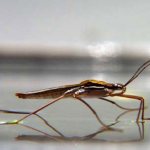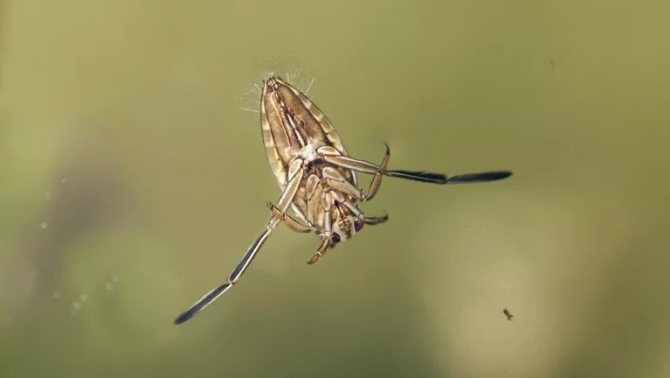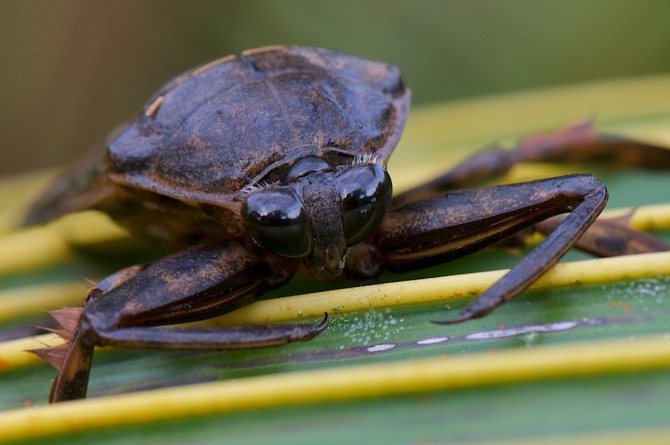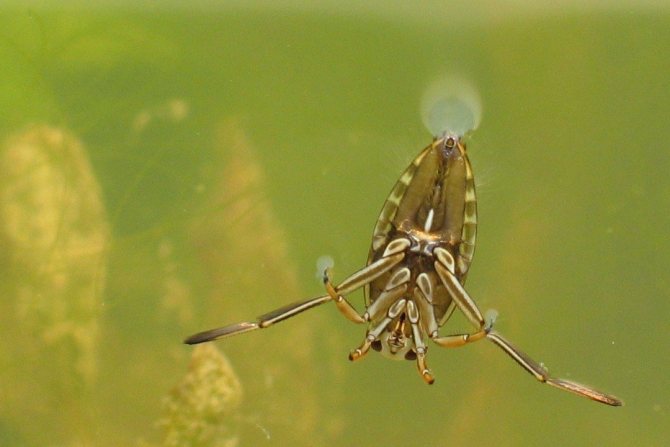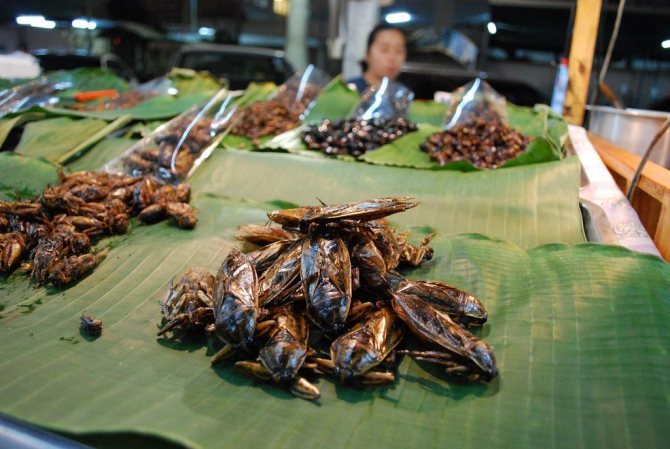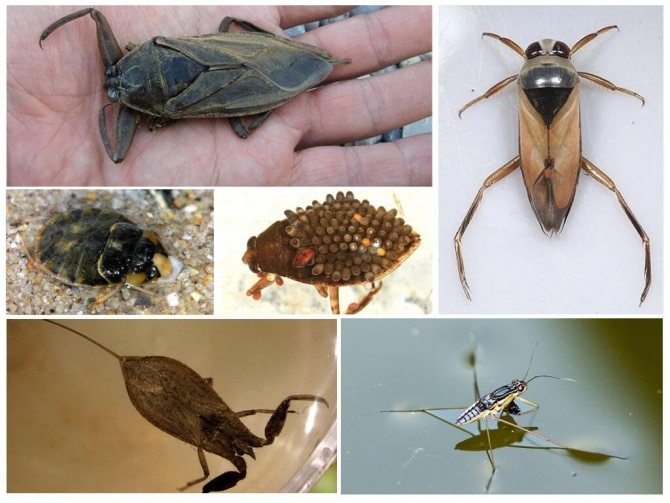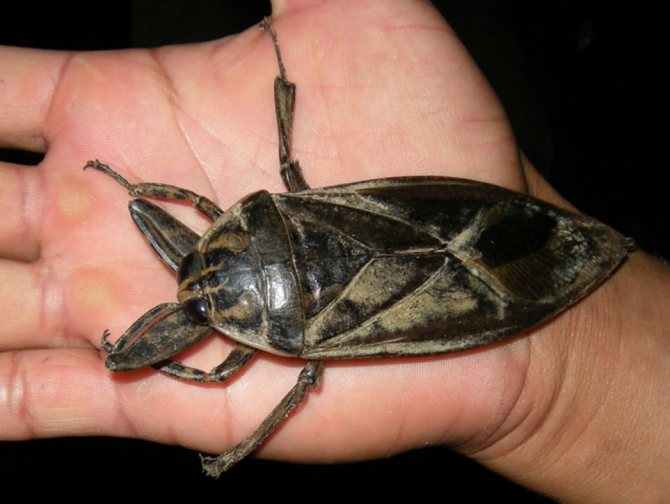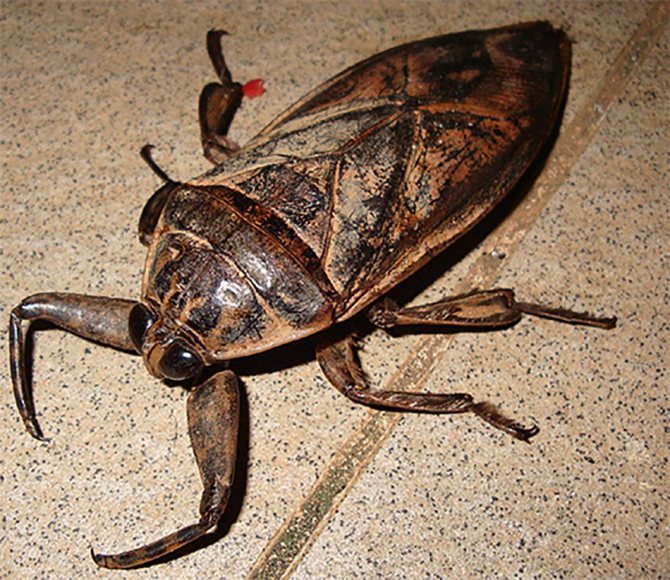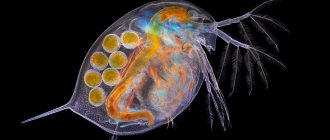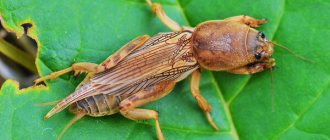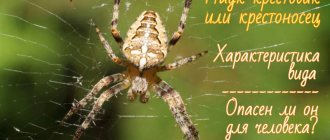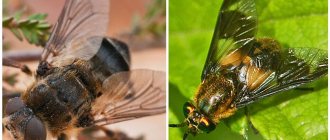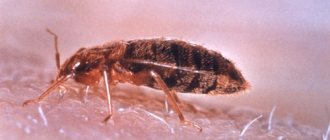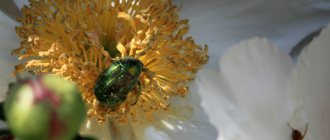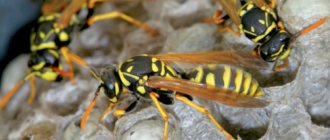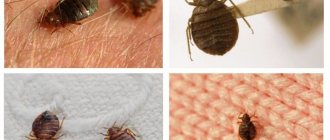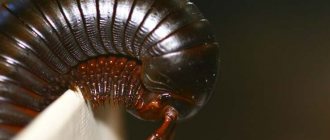It is very difficult to calculate how many varieties of bedbugs there are in nature. Bed bugs that make a person's life unbearable, soldier bugs that live quietly in all parks and forests, a pest of fields - a bug-turtle. But few people know that there are water bugs or smoothies, including giant species. Gladysh is a member of the numerous insect family - Hydrocores.
Since there are many species of bedbugs, they all differ in their external data, duration and way of life, nutrition, size, sometimes truly unique specimens are found. The bedbug not only moves quickly on the water surface, but also flies well. Such mobility is surprising given its impressive size.
Types of water bugs
Four families are most widespread in the world:
- water strider;
- smooth;
- rowboat;
- belostoma.
Each of these species has its own unique characteristics.
Bug water strider
Water striders stand out among their squad by the way they move and hunt. These insects do not plunge into the depths of the water, but spend an active period of their life on its surface.
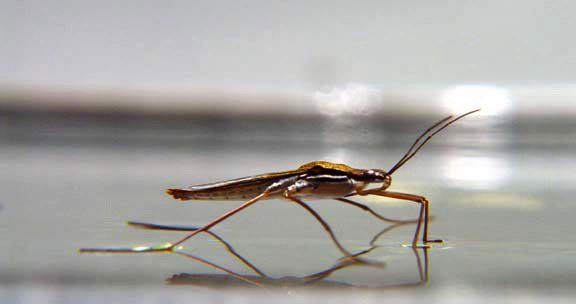
The body shape of water striders is thin and highly elongated. Like all insects, it has three pairs of paws. The two rear pairs of legs are adapted to move along the surface of the water. The insect's low weight and large support area does not allow breaking the surface tension film of the liquid. Pushing off the surface with its feet, the water strider glides on the water. The front legs are used to hold food. The water strider feeds on the emerging microscopic inhabitants of the reservoir and other insects that have fallen into the water. Food is not very common, so water striders have to move a lot in search of food.
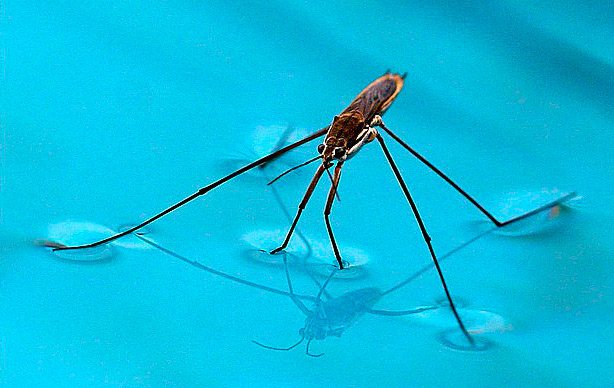

Transparent wings are hidden under hard elytra, which water striders use very reluctantly. Flights occur only when unfavorable conditions occur in the native water body and over short distances. Once on land, the water strider does not stop moving, it only slows down a lot.
Water bug smooth
This insect has a boat-like body. The way of its movement is original and further enhances its resemblance to this ship. When immersed in water, the smoothie turns over with its belly up and begins to work hard with its hind legs-oars. At the same time, huge eyes allow you to observe the upper layers of water in search of prey. Noticing the victim, the smoothhead rushes headlong at her. Small underwater animals and their larvae make up the main diet of the smoothie.
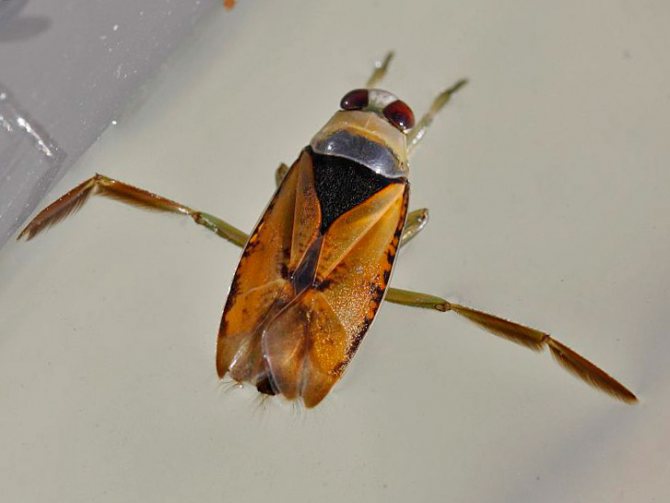

For a long time, the smooth person is helped by an airy film that adheres to the hairs that densely cover the entire body. The smoothie receives the necessary supply of air by floating to the surface and exposing the back of the body to the atmosphere.
The wings of the smooth man are highly developed and allow him to make long flights. He often uses this in search of reservoirs richer in food. A smoothie can live not only in large ponds, but also in small puddles and even in barrels of water. If there is not enough prey, the bug leaves the hunting grounds and looks for a new place. He prefers to travel at night.
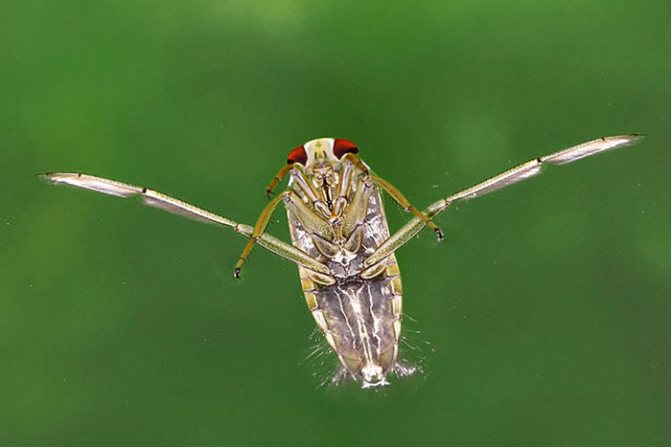

Waterbug rowboat streaked
From a distance, the rower can be mistaken for a smoothie because of his way of swimming. The motor apparatus of the rower is made up of two powerful legs, terminating in hairs-cilia of a large area.However, he prefers to move in the usual manner - with his back up. To replenish the air supply, it floats to the surface and accumulates the atmosphere under the elytra. A large air bubble pushes the body up, and it has to hold onto the leaves and stems of aquatic plants from floating up.
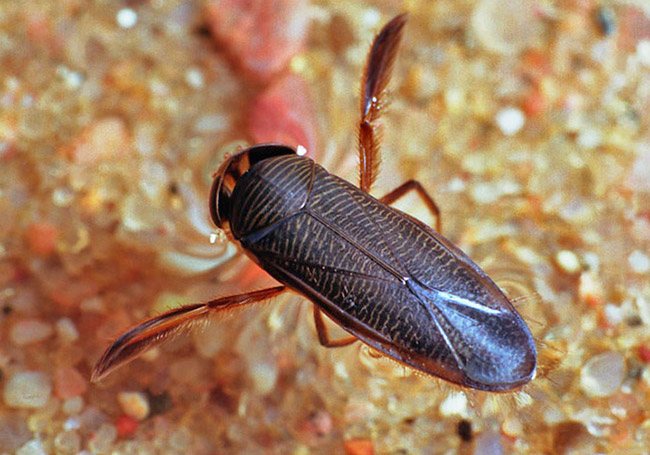

The rowboat is similar to terrestrial relatives by the presence of odorous glands. Discharge from them scares off potential enemies. At the same time, the smell helps to attract individuals of the opposite sex.
The peculiarity of the rower is that he also "sings". The sound is emitted by rubbing the front legs along the proboscis. In nature, people very rarely can hear a rowing boat, since the sound power is very small, moreover, it is heard from under the water. Some people keep these bugs in aquariums with fish, and in the quiet of the apartment you can hear the quiet "voice" of the rower.
Belostoma - giant water bug
The name itself speaks of the size of the insect. If most of its relatives have a body length of 1-2 cm, then the belostoma grows into a 10-centimeter giant. For life, he prefers to choose shallow reservoirs with very warm water. Therefore, belostomas (mecheuses) are common, mainly in the tropics. Although there are species that have adapted to lower temperatures and have settled in the Far East.
Belostoma is nocturnal. It attacks prey from an ambush, striking it with nerve poison. Careless frogs, small fish and miniature turtles become victims of the predator. He attacks the fauna not only smaller than himself, he is not afraid to choose larger specimens as a victim. In some countries, he even received the nickname "fish killer".
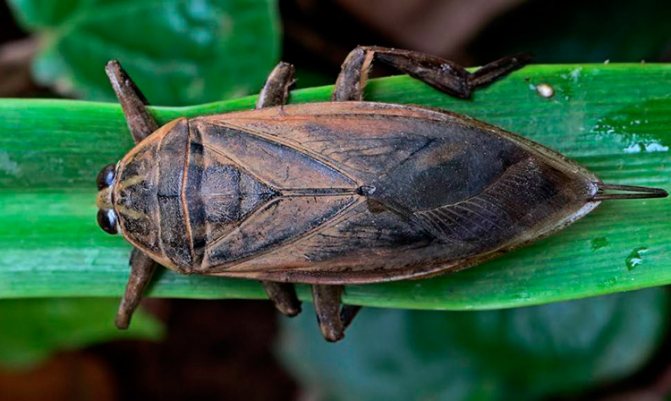

The front paws are highly developed and equipped with large hooks that help to hold the caught prey. The shape of the "fighting" limbs resembles the claw of crabs or, rather, the front legs of a praying mantis. Like others, it has wings, but flies only when necessary.
How to recognize an insect
General characteristics:
- Usually the body length can be about 15 mm;
- Water bugs can bite and give off unpleasant odors;
- The insect has elytra, so it can take off with ease;
- The bite often falls on the fingers and toes, it is quite painful;
- Water bugs are predatory insects;
- They breathe through the tubes that are located on the abdomen, so they constantly float up for the next portion of air.
Most common and numerous smoothies... Their body size can exceed 14 mm. The thoracic region is traced between the abdomen and the head.
They have eyes on their heads that have a reddish tint. The insect feeds in a piercing, sucking manner through the proboscis adjacent to the abdomen. This organ is tough enough for them to pierce human skin and get to the blood vessels. The bite is immediately felt because it hurts. Because of this feature, the smoothie is called the "water wasp".
This insect adopts color from the water in the place where it lives. The color can range from dark green to brownish brown. Sometimes there are bright yellow and even pink individuals. If you look closely, the back and elytra are slightly lighter than the abdomen.
There are 6 legs on the chest. The back pair of legs is slightly longer and stronger, since it is on them that the emphasis is placed when moving through the water. Thick bristles grow on them. Getting out on land, the bug in question moves with difficulty - the front legs cling to the irregularities and tighten the body.
The four-segment abdomen from the back is covered by the elytra. The upper part of the body is slightly curved, and there is a thickening on the abdomen.
It is not necessary to touch the insect specially, it threatens with an instant bite.
Due to the fact that the smoothie inhales atmospheric air, his body has a positive buoyancy. The spiracles are located on his chest. There are 10 pairs in total.Thanks to their movement, the trochean trunks open. Under the elytra are stigmas on the chest, which open into special hermetically sealed chambers. Air channels from the surface of the abdomen are also supplied there. They hide under 4 stripes of hairs. The bug has a main respiratory site, which is visible in the 7th segment of the abdominal part of the body. It is covered with fine hairs. Some of them can move. When the hairs come together, they close the opening of the airway.
This kind of bedbugs like rowers live in latitudes with a temperate or northern climate. They are a little more smooth by a couple of millimeters. In contrast, they move through the water upside down. They can rotate and tilt their head. It has a trunk, which cannot be seen at first glance - it is under the lip. Males differ from females in the structure of the front pair of legs - they have small tubercles that help them make chirping sounds.
Observing these arthropods in stagnant bodies of water, one can notice their ability to fly out of the water in a matter of seconds.
Unlike their congeners, rowers do not have a proboscis with which they could pierce a food source and be full. They eat by opening their mouths and pushing food there with their front paws. In the cold months, they do not hibernate, but continue their active life.
Some species of bedbugs, such as the noxious turtle, the Italian bugbug and the stink bug, leave a specific smell when they fall into the hands of a person. They should be handled with extreme care.
Doesn't pose any threat water strider bug
... They do not avoid people, so you can find him everywhere during the bathing procedure. In the event of a bite (for protection), do not be alarmed, but treat the wound with any antiseptic as soon as possible.
If you met a water strider in hot countries, then get ready for the fact that the bite and for some time after it will be painful, and the area around it may become numb. If you are allergic, be sure to take antihistamines.
Belomastids are excellent swimmers. Nature has awarded the front pair of paws with hooks, with the help of which they catch their prey and do not let go even when it moves.
What do water bugs eat?
Small species hunt animals even smaller than themselves, swim quickly and lead a very active lifestyle. Large insects, such as belostoma, prefer to watch their prey while in cover.
The feeding apparatus of bugs is piercing and sucking, therefore they are not able to eat solid food or swallow prey. The diet of water bugs is varied. Everything is determined by the size of the potential prey. Many species inject poison into the victim's body, slowing down or completely paralyzing them. Having clasped the prey with its paws, the predator pierces its body with its proboscis and sucks out nutrient fluids from it.
Insects, their larvae, fish or amphibian eggs are eaten. Being predators, bugs often fight over prey, and with a poor environment, they are able to devour their fellow tribesmen.
The role of smoothies in nature
Unlike home water corners, it is by no means necessary to specifically destroy water bugs in natural reservoirs. These insects, like all living things, perform important functions. For example, smoothies regulate the number of mosquitoes - one bug can eat up to a hundred of their larvae per day. The fact that water bugs eat fish fry cannot be considered harmful, unless this happens in fish farms. Smoothies participate in the food chain, themselves being food for larger animals. Thus, water bugs are an indispensable link in the ecosystem of a separate reservoir and the entire living world as a whole.
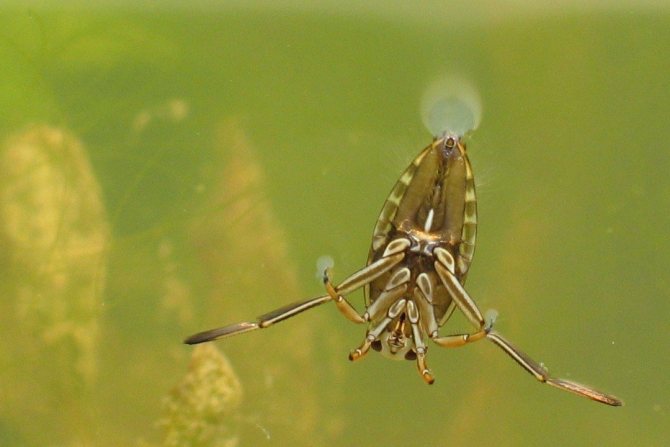

Most of the time smoothies spend on their backs, rowing legs spread out to the sides
For humans, there is also a peculiar benefit of the water bug as a food product. In Asian cuisine, it is considered a delicacy, and in Mexico, smooth eggs are eaten.
Breeding water bugs and caring for offspring
Water bugs reproduce with eggs. Significant differences are observed in the way of laying. The female smoothie lays eggs in the thickness of the plant stems, the rowers place the eggs on the surface of the leaves of algae and other objects under water.
The belostoma bug does not leave its offspring unattended. The female lays eggs on the male's back, filling its entire surface. He walks and swims with eggs on his back. Until the larvae hatch, all the activities of the male are aimed at caring for the offspring. He selects the optimal temperature regime for the eggs, ensures the circulation of water around the clutch, and protects against other predators. It is noteworthy that during the period of egg ripening, the belostoma almost does not eat, therefore, after hatching, the larvae often die.
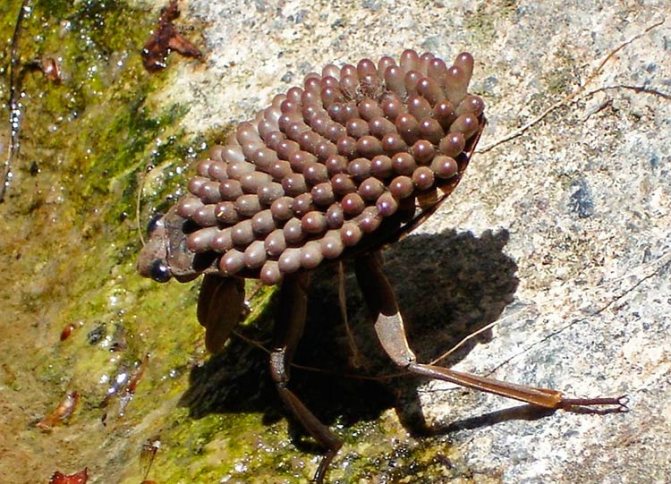

In their life, aquatic insects pass through three steels: an egg, a larva, an adult. The hatched larvae are very similar to adult insects, differing in their smaller size. Before turning into a full-fledged individual, the larvae must go through several molts.
Interesting Facts
- in tropical countries, huge bugs live, whose size reaches 17 centimeters. Locals call them "Alligator Ticks";
- some adults cannot breathe underwater. They are forced to rise to the surface;
- in 2002, in the tropical Pacific Ocean, a huge canister was discovered, covered with 70 thousand eggs in several layers. Since one female cannot lay more than 20 pieces, it means that several thousand females used the canister at the same time;
- water scorpions can send a kind of signal. The sound resembles the chirping of a grasshopper;
- water striders who can slide on the water surface are called Jesus bugs;
- frightened bugs always try to run north;
- some species, during mating, are able to store sperm after mating and reuse.
Is a water bug dangerous to humans?
There is no immediate danger to humans. Due to the huge difference in size, insects living in water do not consider humans as prey. All habitual victims have different sizes and habitats.
Do not consider water bugs to be completely harmless insects. In case of danger, the insect bites. For this, for example, Gladysh was nicknamed the water bee (water wasp) in Germany. Most of the time, the bug is just pretending to be dead. The water scorpion reacts in the same way, if you do not touch it, then there is nothing to be afraid of.
Features of behavior
Smoothies can fly and travel long distances. Take off directly from the water surface or from the ground. Observations have shown that the maneuver occurs belly upward.
Sometimes, when meeting with a smoothie, you can hear chirping similar to that of grasshoppers. These sounds, similar to a kind of singing, can be made by males. They fold their front legs and quickly rub against their proboscis.
To move quickly through the water, such a bug needs to roll over onto its back. From this perspective, he looks completely different and he may not be recognized at all and, accordingly, not touched by various predatory fish. Moreover, its color is similar to the color of the reservoir, and this helps it remain unnoticed from the depths. Birds may also mistake it for an ordinary aquatic plant and not be interested. Throwing back its paws to the sides and pushing off with fins, the smoothie moves calmly and unimpeded on the water.
These predators hunt alone and without ambush. When they are full, they prefer to hide in the near-water thickets to avoid meeting other predators.
Another feature of the smoothie is the love of light. At night, he cannot ignore the light sources.Therefore, he becomes a frequent guest in open gazebos, on verandas and balconies. And in the evening it can be found in the veranda or on the terrace. If you are planning to spend the night in a tent by the reservoir, be sure to meet this creature.
The danger of a water bug bite and its consequences
The pricking apparatus of bedbugs is very sharp, they are quite capable of biting through human skin. The bite of European insect species, although accompanied by the injection of poison, does not cause significant harm to the human body. A small red spot forms on the skin at the site of the bite. As a treatment, it is enough to anoint the affected area with iodine.
The greatest danger to humans comes from tropical bugs, their poison is much stronger. In rare cases, an allergic reaction occurs. The marks on the skin remain visible for a week. A long sting penetrates deep into the body and pain can be felt for tens of minutes. No fatalities have been reported. In order not to be bitten, do not touch such a cute "bug".
Insect feeding
Since water bugs belong to the category of predators, small fish, tadpoles, can easily become their delicacy. To find prey, the bug settles on algae and tracks it carefully. Prefers to eat with creatures living in the upper layer of water. When the fish swims close enough, the insect stretches out its front legs, clings with ticks and pulls directly to the mouth. The bug pierces the fish and poison enters the victim's body through the proboscis, which gradually dissolves all the insides. A nerve agent is present in saliva. After that, the bug can only suck out all the contents.
Scientific observations support cases of cannibalism. Juveniles and larvae fall prey to hungry adults. Other smaller species of water bugs are also attacked by their relatives.

